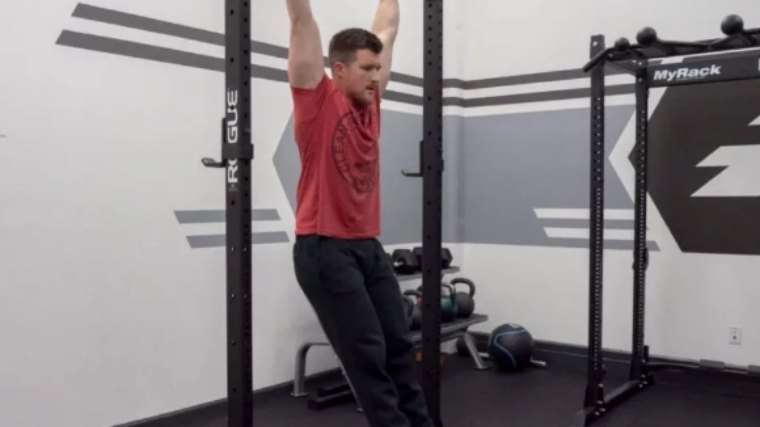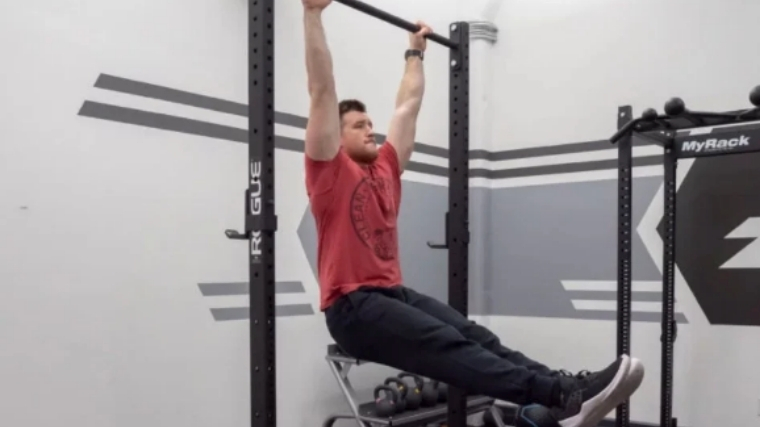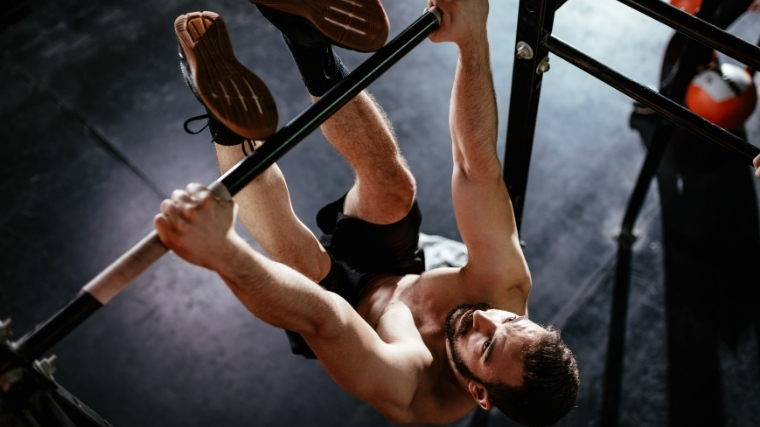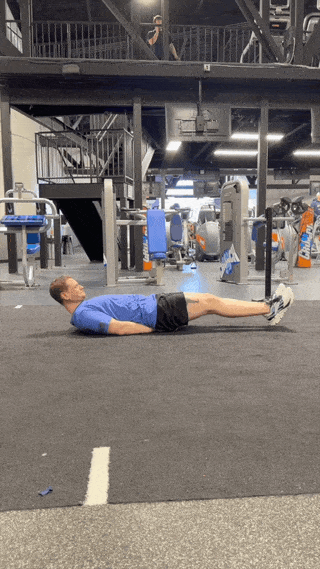Build Ridiculous Core Strength With the Toes to Bar | BarBend (original) (raw)
Don’t let the simplicity of the toes to bar exercise fool you — raising your feet from extension to your head can forge iron-like abs. There are plenty of other reasons to sub this exercise into your ab training rotation. You’ll develop core strength to help you brace during heavy lifts, master a must-know skill for CrossFit (which matters if you’re a CrossFitter), and the toes to bar can be done pretty much anywhere there’s a power rack available — be it your big box gym or home gym.
That said, there are fine points that you need to know when it comes to the toes to bar. And we’ll outline them in our handy guide, along with exercise variations, alternatives, and programming recommendations.
- How to Do the Toes to Bar
- Benefits of the Toes to Bar
- Muscles Worked by the Toes to Bar
- Who Should Do the Toes to Bar
- Toes to Bar Sets, Reps, and Programming Recommendations
- Toes to Bar Variations
- Toes to Bar Alternatives
- Frequently Asked Questions
Editor’s note: The content on BarBend is meant to be informative in nature, but it should not be taken as medical advice. The opinions and articles on this site are not intended for use as diagnosis, prevention, and/or treatment of health problems. It’s always a good idea to talk to your doctor before beginning a new fitness, nutritional, and/or supplement routine. None of these supplements are meant to treat or cure any disease. If you feel you may be deficient in a particular nutrient or nutrients, please seek out a medical professional.
How to Do Toes to Bar
There are two main toes to bar variations, strict and kipping. Though both versions are discussed, the below step-by-step guide is for strict toes to bar.
- Strict Toes to Bar: Strict toes to bar is one of the hardest exercises you can do for core strength and development. By increasing your strength, coordination, and control of this movement, kipping toes to bar should be a breeze once you learn kipping skills. If you choose to go directly to kipping toes to bar but don’t learn the basics, you could be setting yourself up for stalled long-term progress and possibly injury.
- Kipping Toes to Bar: Kipping toes to bar is commonly seen in competitive fitness, CrossFit, and gymnastics. The kipping motion creates momentum with your body to help you eke out more reps.
Step 1 — Actively Hang

Start by hanging from a bar with the hands slightly wider than shoulder-width apart. The thumbs can be wrapped or unwrapped, with the head cradled in between the biceps. Squeeze your abs by pulling your belly button into your body, engage your legs and glutes, and point your toes.
Form Tip: Think about pulling the bar downwards so that your shoulder blades are depressed and slightly retracted (like a scapular pull-up). This, in addition to keeping midline stability, will minimize swinging of the torso.
Step 2 — Pull Back on the Bar

To bring your feet all the way up to the bar, you need to engage your back muscles and lean back a bit. Pretend you’re performing a straight-arm pushdown, and push your palms into the bar as if you were going to arch them forward and down. Your head should move behind your biceps, which is the position you want to be in before step three.
Form Tip: Stay tight in this position. As you get fatigued, be sure to pull down harder onto the bar for assistance.
Step 3 — Squeeze and Lift

Flex every muscle in your body — your back, abs, legs, butt, and arms — and begin to raise your legs as you actively pull the bar down with your hands.
Form Tip: If you have issues doing this strictly, be sure to first pull back harder onto the bar.
Step 4 — Kick the Bar

As you approach the top of the movement (either with straight legs or bent knees), you will need to make one more final effort to kick the toes towards the bar.
Form Tip: Kicking, or rather, flicking the toes to the bar, can add some much-needed momentum (don’t use this step if you are doing these strict).
Benefits of Toes to Bar
Below are a few benefits on toes to bar (both strict and kipping). If a benefit is inherent to a specific style of toes to bar (strict or kipping), it shall be noted below.
Increased Core Strength
Kipping, strict, with your knees bent or legs straight — raising your legs up and down from a hanging position will increase your core strength. Hanging creates an environment where your abs and all the stabilizer muscles around your abs need to work overtime to keep your body rigid. Then, your rectus abdominis — aka your six-pack — flexes to bring your legs up.
Better Scapular Control
The toes to bar is marketed as a core exercise, but your back is a key player, too — specifically, the shoulder blades. Your shoulder blades, or scapula, need to be squeezed back and together so that your shoulders are set in place for maximum stability. By retracting your shoulder blades — and keeping them retracted — you’re reinforcing proper posture.
[Read More: The Best Shoulder Exercises and Workouts for Bigger, Stronger Shoulders]
A Stronger Grip
The muscles in your forearms and hands will work hard as they’re supporting your entire body weight as you hang from a pull-up bar. The toes to bar will certainly strengthen your grip.
Muscles Worked by the Toes to Bar
Below is a listing of the various muscle groups that are targeted. Note: Kipping increases the demands on grip, shoulders, and back muscles and overall muscle damage due to the vast increase in eccentric strength and control needed to perform repetitions in a cyclical, ballistic fashion.

MilanMarkovic78/Shutterstock
[Read More: The Best Ab Exercises & Workouts, According to a CPT]
Abdominals
The abdominal muscles are responsible for spinal flexion and assisting in hip flexion. During the toes to bar, both actions occur. When done with a stricter tempo, the toes to bar can have a highly eccentric component, furthering muscle damage and growth.
Hip Flexors
The hip flexors are responsible for flexing the hips and aiding the abdominals during the movement. For individuals who have a tough time isolating the abdominals, the toes to bar may not be the best option. Instead, a regression like the knee raise — which reduces the involvement of the hip flexors — may be a better option.
Forearms
The forearms are the bridge between your hands and the rest of your body, so they’re directly involved in this movement.
Lats
The lats maintain proper positioning and shoulder stability throughout the range of motion.
Who Should Do the Toes to Bar?
Below we will discuss what types of athletes can benefit from toes to bar, and why.
Strength and Power Athletes
Strength and power athletes can use toes to bar (strict or kipping) to increase core strength, midline stability, enhance grip strength, and increase overhead/thoracic mobility. Because of the momentum, kipping toes to bars may cause undue shoulder pain. So, sticking with the strict version may be a better option for strength athletes who are pressing weight overhead.
- Powerlifters: A stronger core and grip carry over to every lift in powerlifting (the bench press, deadlift, and back squat).
- Strongmen and Strongwomen: It increases core strength, midline stability, and stamina of the grip and core muscles is key for maximal performance when under load.
- Weightlifters: Olympic weightlifters can use this exercise to increase core strength, achieve midline stability in the arms overhead position, decompress the spine (strict versions with long hangs), and increase thoracic mobility/scapular stability.
Functional Fitness Athletes
In addition to the above benefits for strength and power athletes, toes to bar is a sport-specific movement for CrossFit and functional fitness athletes. This can be used to increase gymnastics abilities, toes-to-bar performance in WODs, and increase core strength and stamina.
General Population
Toes to bar is a great move for everyday gym-goers because it’s accessible and simple. That said, many folks — especially people who are just starting — will most likely need to start with a regression of the toes to bar. The hanging knee raise is a great move to get stronger at first.
Toes to Bar Sets, Reps, and Programming Recommendations
Below are some general guidelines on how to start programming the toes to bar into your workout. Remember that the sets and reps listed below are just suggestions, and you may need or want to perform more or less. Use these recommendations as a starting point and then adjust as needed.
To Improve Strength and Technique
To get stronger, you want to do fewer reps and more sets. Aim to perform four to six sets of four to eight reps. Rest two minutes between sets. To increase the resistance, you can also hold a light dumbbell between your feet, loop a resistance band around your ankles while the other end is anchored to the floor, or have a partner add manual resistance to your feet.
To Build Muscle
Muscle gain is all about volume and, usually, more is more. So, you’ll Perform four to six sets of eight to 15 repetitions. Rest for one minute between sets. More time under tension is a factor for muscle growth, too. You can add more tension by using the resistance techniques mentioned above or by following a slower tempo.
To Increase Muscle Endurance
If you’re an athlete who needs to prep for high-rep core work and/or exercise, then do three sets of 12 or more reps. Rest for just 45 seconds between sets.
Toes to Bar Variations
Below are three common toes to bar variations that can be done to improve your toes to bar skill and, if you’re not strong enough to do toes to bar yet, work up to your first.
Hanging Leg/Knee Raise
This exercise is very similar to the toes to bar, except that you don’t bring your feet all the way. If you’re a true beginner, keep your knees bent at 90 degrees. This takes the hip flexors out of the equation. Once you have that down, extend your legs so your hips are working harder and your center of gravity isn’t as compact. Follow the same set and rep schemes listed above and then eventually try a full toes to bar rep.
[Read More: The Most Effective Workout Splits, Created by Our Experts]
Tempo Toes to Bar
Another way to scale the move is to perform your reps more slowly. Try raising your legs to a count of three seconds, pausing at the top for two seconds, and lowering your legs to a three count. You won’t be able to do as many reps, but the overall time under tension will be about the same.
Single-Leg Toes to Bar (Alternating)
What’s harder than a toes to bar? Lifting one leg at a time while keeping the other one extended. This is a difficult variation and should only be attempted once you have full mastery over strict toes to bar.
Toes to Bar Alternatives
Below are three toes to bar alternatives that can be done to change up your programming and challenge lifters in a slightly different way.
Lying Leg Raises
Lying leg lifts are a regressed version of the hanging toes to bar and can be done to increase lower abdominal strength and teach the leg movement of the toes to bar. Additionally, this regression helps a lifter understand how to maintain core tension throughout the entire range of motion.
[RELATED: Best Leg Exercises]

Knees to Elbows
This hanging regression has the lifter perform all the same steps as the toes to bar, with just a smaller range of motion. To do this, the lifter pulls their knees to the elbows rather than the toes to the bar. This can be done both strictly or in a more ballistic manner to improve skill for the kipping toes to bar.
Dragonfly
The dragonfly is a more advanced version of the lying leg raise that has the athlete lifting their hips and legs straight into the air, maintaining control, and slowly controlling the eccentric aspect of the movement. This exercise is highly eccentrically focused, meaning it can be great at increase muscle growth. It will leave you sore!
FAQs
When should I do the toes to bar?
Save this variation for the end of your workouts. Otherwise, your risk fatiguing your core, which you’ll want to be fresh for heavier exercises such as the deadlift and back squat.
How many sets and reps of the toes to bar should I do?
It depends on your goal, but here’s a general rule of thumb.
- For more muscle: Do four to six sets of eight to 15 reps.
- For strength: Do four to six sets of six to eight reps (using resistance if possible).
- For endurance: Do three sets of 12 or more reps.
Should you do strict toes to bar or kipping?
Stick with strict toes to bars unless you’re a CrossFitter who specifically does the kipping version. The kipping version isn’t any better for developing ab strength, and the movement required can possibly cause undue shoulder stress. That said, kipping isn’t entirely bad. You just need to know what you’re doing and why you’re doing it.
Featured Image: MilanMarkovic78/Shutterstock